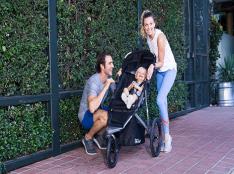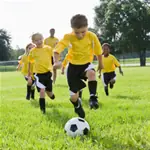
Do you remember your first bike—the color, brand, size, weight and feel? It's the definition of freedom for kids, a pass to adventure, but they really can't learn to ride it without your help. And who would want them to? It's the passing of a baton—a cherished childhood pastime going from one generation to the next.
But before they can go fast and far, there's a lot to learn and practice: how to balance, when to ride and brake, where to ride and not ride and more. The questions abound, and with this unknown there can be some nerves (for kids and for parents). Prioritizing and adhering to basic safety rules, safe practices and skills will build the necessary foundation for their much-anticipated fast rides and freedom on the bike.
From wearing a helmet no matter what to learning the basic hand signals and bike maintenance checks, there's a lot you can do with your child on their first bike rides that will keep them safe on the road well into their teen years (and beyond).
Helmets First
A good rule for anyone: no helmet, no bike ride.
Making the helmet a "cool" choice can be a challenge, but there are so many different colors and style options to choose from that it's easy enough to find some degree of choice for kids within the non-negotiable requirement of wearing one.
Football helmets and hard hats are protective in their own right, but they're not for cycling—if your child is on a bike, you'll want them wearing a helmet built and designed for riding bikes. Prior to simply making sure that your kids are using and buckling (yes, buckling!) their helmet onto their heads, you'll want to help make sure it's a proper fit. Click here for detailed guidance on how your kids should wear and adjust their helmet, as well as a size and safety guide for selecting the best helmet for your child's needs.
The Right Bike
Having the right size, weight and style of bike is one of the best ways to help your child avoid bicycling injuries and enjoy riding their bike. You'll want them to be able to stabilize themselves when stopping with a seat height that allows them to easily reach the ground from the pedals.
Finding the right size can be a challenge! Kids grow quickly, and there's a lot to consider from wheel and frame size and weight (a heavy bike that is hard to maneuver won't make for easy riding) to brakes, gears and training wheels (if needed).
Click here for a sizing chart and some helpful tips for making sure your child is on the right size and type of bike.
Be Seen
Lights! Bright clothing! Reflective gear! Help your child dress appropriately for bike rides no matter where they're pushing the pedals so they can be comfortable (with the exception of no loose clothing that could easily catch their chain or wheel) and can easily be seen by others (walkers on walking paths and ultimately drivers on the streets). That neon helmet or bright yellow jacket will even help you keep an eye on them when riding in busier parks or neighborhoods.
You'll especially want to make sure their bike is properly outfitted with reflective panels and lights once they've progressed to riding around your neighborhood's streets or alongside busy roads. Even in daylight bike lights and reflectors work to catch the eye of drivers and passersby so riders can more easily be seen. Most bikes come with reflectors, but lights and additional reflector stickers can be purchased at most stores that sell bikes.
When & Where to Ride
Learning how to ride a bike isn't just about developing the strength and skills to maneuver the bike while pedaling, it's also about learning how to do so safely in many different environments.
Start out by making sure your child is riding in a good place for their confidence and skill level and at the right time of day. For example, you may want them to avoid night riding entirely, or make sure you are riding with them during dimming daylight or evening hours. When considering time of day, you might also want to consider traffic in your park or neighborhoods at that time, making sure that while they're gaining confidence on the pedals, they're navigating limited-to-no interactions with cars (parked or in motion for that matter). Knowing your neighborhoods and local routes will make all the difference.
When it comes to taking street routes in your neighborhood or around town, you'll also want to make sure they've practiced riding with traffic on the same side of the road, stopping at stop signs, looking both ways before proceeding into an intersection and keeping an eye out for driveways. Even after the boundaries you set for them dissolve (for example, riding only between certain mailboxes or street corners), there will always be rules about where a cyclist is safest (and allowed) to ride on the road. Help them build this awareness and practice skills while they're safely riding with you in controlled situations.
Basic Maintenance
Prior to setting out for a bike ride, it's good practice for kids to check their tires for flats and adjust their seat as needed. Riding with your seat too high is a likely to result in falls or injuries, as it's difficult for them to catch themselves or dismount the bike in a hurry if needed. Riding with flat tires is just difficult for maneuvering—another accident risk, let alone unfortunate if noticed once far from their tire pump at home.
Simply encourage them to check to make sure things are in good working order before setting out for adventure is a good lesson to instill in them from the start. As they grow up, these basic checks can turn into basic fixes that they'll know how to handle to keep their bike in good working order for safety and ease of use on the road.
Hand Signals & Rules of the Road
When they're old enough to ride on their own (to school, to work, along busy streets, etc.), you'll want to be sure they keep a few additional safety measures in mind. From knowing how to communicate with drivers on the road to having the skills and/or technology necessary to be able to navigate and find their way to and from their destination, there's quite a bit more to keep in mind.
While a great deal of the latter will come with time and ultimately learning to drive a car, it's never too early to teach hand signaling for driver communication. You can even set up a fun obstacle course with chalk on the driveway to practice the signals while they're young. Here's a quick video demonstrating them to get started.
READ THIS NEXT: 8 Reasons Your Kid Should Try Cycling









Discuss This Article